While you love your dog, bad breath can make even the most dedicated dog parent flinch a bit. Integrative veterinarian Dr. Julie Buzby explains why dogs have bad breath, how to get rid of bad dog breath, and what you can do to prevent your dog from developing bad breath.
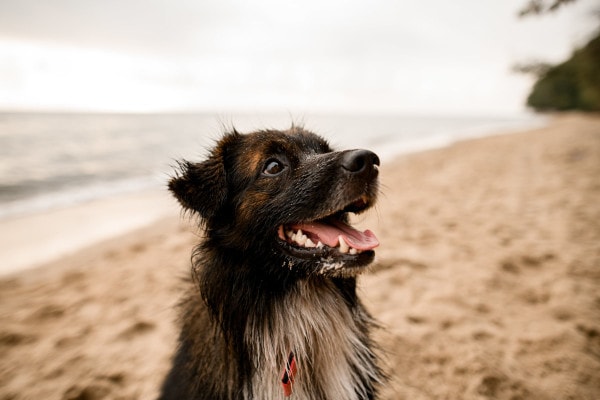
Have you ever wondered why your dog’s breath is stinky? Of course you love him or her, stinky breath and all. But it is important not to overlook bad breath in dogs. Contrary to popular belief, having “dog breath” isn’t necessarily normal, especially when it comes on suddenly.
As you will soon discover, bad breath (i.e. halitosis) in dogs can point to a variety of health conditions.
Why does my dog’s breath smell so bad?
For a dog, bad breath tends to be the result of dental disease (or other dental problems). But it can also come from other conditions that are unrelated to the dog’s mouth. First, let’s take a look at dental conditions since they are the most common culprits. Then we can look at some of the other causes of stinky breath in dogs.
#1: Bad breath due to dental disease in dogs
When thinking about dental issues that can cause bad breath, dental disease in dogs (i.e. periodontal disease) is the by far the most likely suspect. Dental disease occurs when bacteria in the mouth lay down a slimy substance (i.e. plaque) on the teeth. Plaque deposition causes gum disease and inflammation of the tissues that anchor the teeth in place. Left unchecked, dental disease can lead to bone loss around the teeth and eventually an older dog losing teeth. Or the dog may develop a dog tooth root abscess.
Which dogs are the most prone to bad breath from dental disease?
Dogs of any age can develop dental disease. In fact, 80% of dogs over the age of three years have evidence of dental disease. But some dogs are more prone to it than others.
For example, small breed dogs are more likely to develop dental disease than large breed dogs. This is in part because their teeth tend to be more crowded together. Also, senior dogs are more likely to have dental disease. Due to their age, there has been more time for tartar and plaque to accumulate and cause problems. This is especially the case if the dog has not had routine dental care. But even dogs who receive regular at-home dental care can have dental disease.
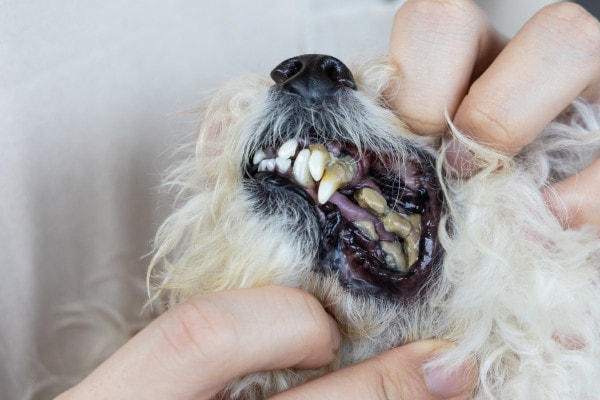
Based on this, senior small breed dogs are the most likely to have dental disease.
Symptoms of dental disease
If your dog’s breath smells foul due to dental disease, you also might notice:
- Excessive drooling
- Red gums
- Dog keeps licking lips or smacking lips excessively
- Decreased appetite or difficulty eating
- Dropping food or water when attempting to eat or drink
- Being unwilling to play with dog toys
- Signs your dog is in pain when you touch the face or mouth
- A swelling under the eye, which may rupture and drain
- Visible plaque and tartar (i.e. tan, brown, grey, or black substance) on the teeth
- Chewing on one side of the mouth or tilting the head while eating
- Pawing at the mouth
- Swollen lymph nodes in dogs under the jaw (i.e. submandibular lymph nodes)
#2: Bad breath due to other dental problems
Additionally, dogs may experience other issues with their mouth that can lead to bad breath. For example, they may have dead teeth or teeth that are chipped and broken. Or they may have gotten an object such as part of a stick, toy, or bone wedged across the roof of the mouth or between two teeth. And dogs can also get wounds in the mouth from chewing on a sharp object or licking a caustic substance. Plus, there are a variety of types of mouth cancer in dogs that could cause bad breath.
Symptoms of other dental problems
Often, the symptoms of dental disease and other dental problems end up being pretty similar. Both have the potential to cause inflammation in the mouth and oral pain. Should the dog have something stuck in his or her mouth, the bad breath and symptoms often come on suddenly, rather than gradually with dental disease. Depending on the dental problem, you may also notice abnormalities with the appearance of the teeth or gums (e.g. discolored dead teeth, fractured teeth, wounds on the lips or gums, or masses in the mouth).
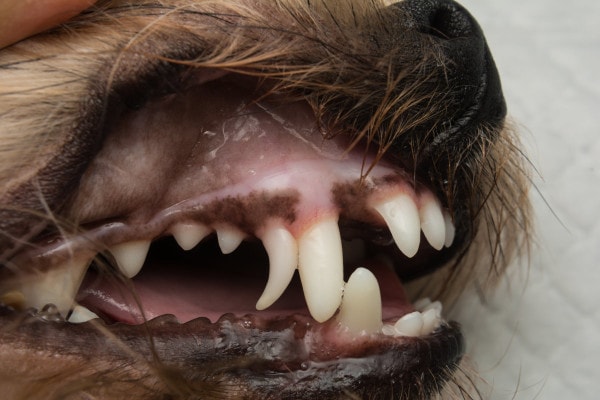
Dental issues are the most common cause of bad breath. But it is important to recognize that other illnesses could be the culprit as well.
#3: Diabetes as a cause of bad breath in dogs
Diabetes in dogs (i.e. diabetes mellitus) is a condition where the dog’s pancreas doesn’t make enough insulin to send the glucose in the blood into the cells. As a result, the dog has high blood glucose levels. And his or her cells don’t have access to the glucose they need for energy. This may force the body to start breaking down fats for energy, and lead to a life-threatening condition called diabetic ketoacidosis (DKA in dogs).
In addition to the other symptoms of diabetes such as increased thirst in dogs, increased urination, and weight loss, dogs with DKA may also have sweet-smelling breath due to the circulating ketone bodies (breakdown product of fat). Interestingly, not all people can smell ketones, so you may or may not be able to detect this change.
#4: Bad breath due to kidney failure
A dog’s kidneys are responsible for filtering waste products out of the blood and excreting them in the urine (among other things). But in kidney failure in dogs, the waste products build up in the body. This can lead to a specific type of bad breath known as uremic breath. Typically, kidney failure breath smells like urine or ammonia.
Dogs with kidney disease may also show symptoms such as increased thirst and urination, vomiting, being a lethargic dog, oral ulcers, or weight loss. The severity of the symptoms, and whether or not the dog has uremic breath will depend in large part on the stage of kidney disease in dogs that your canine companion happens to be in.
#5: Liver disease as a cause of bad breath in dogs
Along the same lines, one of the jobs of the liver is to remove toxins from the body. So in cases of liver disease in dogs, toxins can build up and cause bad breath. Additionally, as the liver fails, the dog may show signs such as lethargy, poor appetite, jaundice (i.e. yellowish color to skin and mucous membranes), a pot-bellied dog appearance, or spontaneous bleeding.
#6: Bad breath in dogs due to skin infections
Sometimes if a dog has a bacterial skin infection (pyoderma in dogs) or a dog paw yeast infection and is doing a lot of licking of the affected areas, the dog’s breath, as well as the dog’s skin, may have a bad smell. Or if the infection is close to the mouth or lips, it could be the smell of the infection you are detecting rather than your dog’s breath.
Dogs with allergies or skin infections may also have red and irritated areas of skin, crusts or pustules on the skin, or areas of hair loss. And the dog may be licking, scratching, or rubbing on the ground excessively due to itchiness.
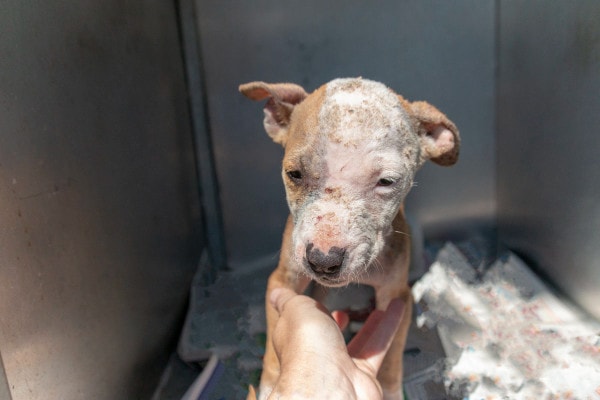
#7: Respiratory infections as a cause of bad breath in dogs
Additionally, dogs with a respiratory infection (e.g. pneumonia in dogs or a sinus infection) may also have bad breath. Depending on the severity and location of the infection, you may notice other symptoms such as nasal discharge, your dog coughing and gagging, your dog breathing fast, lethargy, or abnormal-sounding breathing.
#8: Bad breath due to megaesophagus
Megaesophagus in dogs (i.e. a dilated esophagus with a reduced ability to move food to the stomach) may lead to a dog regurgitating food and water. If this happens often, it is possible that your dog’s breath may start to smell bad.
#9: Persistent vomiting as a cause of bad breath in dogs
Along the same lines, if a dog is frequently vomiting, he or she may also start to develop bad breath that smells like vomit. Depending on the reason for the vomiting, your dog may be showing a variety of other signs (e.g. diarrhea, poor appetite, abdominal pain, lethargy).
#10: Eating something that smells bad can also cause bad breath
This one might be a no-brainer. But if your dog eats poop out of the kitty litter box or while outside, gets into the garbage, eats a dead animal, or puts something else foul-smelling in his or her mouth, the result is stinky breath. Thankfully, this sort of bad breath is short-lived (assuming, of course, the dog isn’t a repeat offender).
What should I do if I notice my dog has bad breath?
There are so many different health problems that could cause bad breath. So, the best thing you can do for your dog with breath that smells bad is to get him or her to the vet. This is probably the most important piece of advice provided in this article.
Some of the conditions that cause these problems (like kidney disease or diabetes) can get increasingly worse with time—especially if they are left untreated. And dental disease can be quite painful when it becomes severe.
Note about sudden extremely bad breath
Additionally, if your dog suddenly develops extremely bad breath, it is particularly important that you examine your dog’s mouth and contact your vet quickly. Bad breath shouldn’t just “appear overnight.” And if it does, it could indicate that your dog has a:
- Tooth fracture
- Object lodged in the mouth
- Wound in or near the mouth
- Underlying condition like kidney or liver failure
While any dog with bad breath should be seen by a vet, in these cases, it is especially important to seek medical attention for your dog promptly.
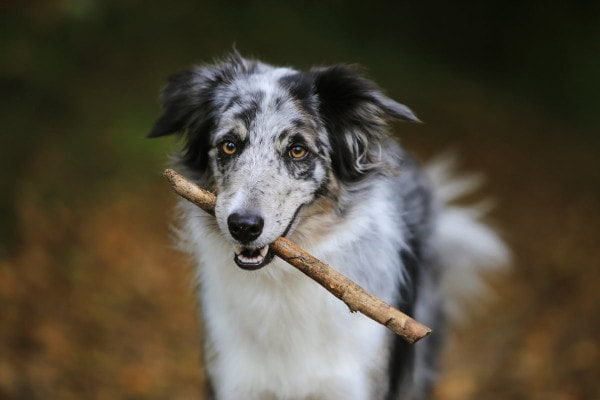
How will the vet find the cause of my dog’s bad breath?
During the appointment, your vet will ask you questions about your dog’s history and any symptoms you might have noticed. Then he or she will carefully examine your dog from nose to tail, paying special attention to your dog’s teeth, gums, lips, and tongue. If the vet sees signs of significant dental disease, chances are good it is the reason for the dog’s bad breath.
But if the oral exam is normal, the vet may recommend other diagnostic tests to try to get to the bottom of the bad breath. For example, if the symptoms fit, he or she may want to run blood tests for dogs to check for diabetes, kidney disease, or liver disease. Or the vet may want to take X-rays to look for a megaesophagus, GI obstruction (as a cause of persistent vomiting), or other abnormalities.
How can you get rid of bad dog breath from dental disease?
For dogs who the vet determines have bad breath as a result of dental disease, professional dental cleanings under general anesthesia are often the best treatment. This involves having your dog’s teeth cleaned to remove plaque and tartar. At the same time, the vet will inspect and X-ray the teeth to assess the health of the teeth. If any of the teeth are loose, fractured, abscessed, or dead, the vet may also recommend a dog tooth extraction during the dental procedure.
Typically, this approach is the most effective one for treating bad breath due to significant dental disease. The home remedies and products we are going to talk about soon can be great for preventing bad breath or for addressing slightly bad breath when dental disease is mild. But they aren’t going to be sufficient for dogs with moderate or severe dental disease.
How can you get rid of bad dog breath from other causes?
Alternatively, if your veterinarian determines that the cause of your dog’s bad breath is something other than dental disease, the treatment will be heavily dependent on the initial problem. For example, at first the vet may need to hospitalize a dog who is dealing with diabetic ketoacidosis or is in kidney failure. And then he or she can create an at-home treatment plan once the dog is stabilized.
After the illness causing the dog’s bad breath is under control, your dog’s breath may improve as well. But if not, your veterinarian might recommend some other products or home remedies to help treat bad breath.
What are some dog bad breath home remedies?
If you have already consulted your vet and followed any treatment recommendations, and your dog still has bad breath, here are some other things you can try at home (with your vet’s approval):
Note: The best course of treatment for your dog’s bad breath is to make an appointment with your vet and follow his or her recommendations. The suggestions below are not a substitute for appropriate veterinary care.
1. Brush your dog’s teeth
Brushing your dog’s teeth is one of the most effective ways to try to improve your dog’s bad breath at home. And it is a great way to prevent bad breath in the future too. Tooth brushing removes plaque and debris from your dog’s mouth, teeth, and gums—just like when we brush our own teeth.
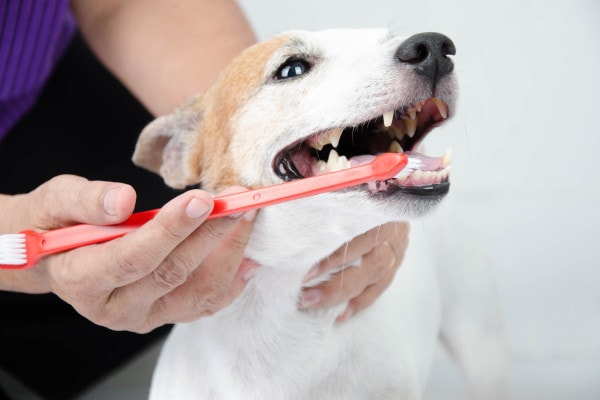
Much like humans, brushing a dog’s teeth daily is the ideal way to reduce dental disease and stinky breath. But at a bare minimum, brush your dog’s teeth at least two times a week to increase your dog’s chance of having a healthy (and fresh-smelling) mouth.
NOTE: You should not use human toothpaste on dogs. It may contain ingredients that are not safe for your pup. Toothpaste designed specifically for dogs is always best.
Brushing your dog’s teeth also gives you a great opportunity to examine your dog’s mouth for signs of gum disease, broken teeth, or foreign objects lodged in the mouth. (If you want to learn more about what a normal mouth looks like and how to examine your dog’s mouth, check out my master class—The Tip-To-Tail Dog Health Scan™.)
2. Give your dog dental chews and treats
There are many different useful oral health products for dogs available, including dental chews and dental treats (e.g. Greenies®). When looking for a product, choose one with the VOHC (Veterinary Oral Health Council) Seal of Acceptance. The VOHC Seal is awarded to products that demonstrate the ability to control plaque and/or control tartar in dogs in two scientific trials. Therefore, when you pick a product with the VOHC seal on it, you know that it should be effective.
Alternatively, regular chew toys can also help control plaque and tartar to some extent. However, it is important that you choose safe chew toys for dogs. Chewing on toys that are too hard (such as antler chews for dogs) can fracture your dog’s teeth. This leads to even more dental issues.
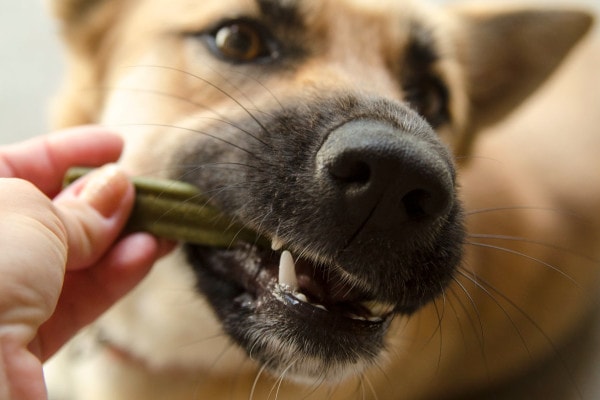
If you are not sure whether a chew or treat is safe or helpful for your dog’s breath, please consult your veterinarian. Or you can take a look at the list of VOHC Accepted Products for Dogs.
NOTE: Do not give mints or gum intended for humans to your dog to freshen his or her breath. Mints and gum designed for people often contain dangerous ingredients like xylitol (e.g. birch sugar), which is toxic to dogs.
3. Use dental water additives or sprays
There are some water additives and mouth sprays on the list of VOHC accepted products. They may help reduce the risk of plaque build up, remove bacteria, or freshen the dog’s breath. However, it is important to note they are not as effective as tooth brushing. Since they don’t apply friction to the teeth, it is harder for water additives or tooth sprays to remove the existing plaque and tartar.
NOTE: Sometimes dog parents ask about putting baking soda in the dog’s water for bad breath. I often do not recommend doing this because baking soda could cause stomach upset. Plus, it does not treat the underlying cause of the bad breath.
4. Feed your dog a specially-formulated dental diet
If your dog has bad breath from dental disease, another option is feeding him or her a dog food that is specifically formulated to address dental disease. Typically, the best dental diets are a hard kibble that encourages your dog to chew. They may be designed to create friction against the teeth so that they work a bit like an edible toothbrush.
Usually (but not always) soft or canned diets are less likely to help with dental disease. Your veterinarian can help recommend the best dog food choice for your dog. And the VOHC Accepted Product List also provides a few dental diet options.
5. Give your dog yogurt and probiotics
Alternatively, if your dog’s smelly breath is from stomach upset (not dental disease), yogurt and probiotics can be a helpful natural remedy. They won’t address the smell directly. But they could help treat the underlying problem that is causing the stinky dog breath.
6. Prevent your dog from eating stinky things
If your dog’s bad breath is mostly due to the fact that he or she likes to eat stinky things, addressing the bad breath centers around preventing those activities. Maybe it means using a baby gate with a cat-sized hole to block off the rooms with the litter box. Or it might mean keeping your dog on a leash so you can stop him or her from eating foul-smelling things when outside.
7. Work with your vet to treat and prevent bad breath
The home remedies on this list tend to be the best and safest ways to help reduce your dog’s bad breath (in addition to professional dental care or otherwise addressing the underlying condition). But if you aren’t sure what to do for a dog with bad breath or if a product is safe, please always consult your veterinarian.
And also consider talking to your vet about how you can prevent your dog from getting bad breath in the first place. After all, prevention is the best medicine!
How can you prevent bad breath in dogs?
There are ways to address bad breath once it happens. But especially when it comes to bad breath from dental disease, prevention can go a long way. Some potential strategies include:
- Brush your dog’s teeth regularly. (Daily is ideal.) This is by far the best way to prevent dental disease in dogs.
- Choose dental chews and dog food designed to promote oral health. Dental chews can provide a safe outlet for chewing and help control plaque and tartar at the same time. And dental diets can be another great way to keep your dog’s teeth healthy. (Both are still less effective than tooth brushing, though.)
- Don’t let your dog chew on bones, toys, or other things (e.g. rocks, metal bars of the dog crate, sticks, etc.) that may damage the teeth or gums. These objects can get lodged in the teeth. Or they can break the teeth or wear them down over time, leading to exposure of the pulp (e.g. inner substance of the tooth) and an increased risk for infection.
- Talk with your vet about scheduling routine professional dental cleanings every one to three years for dogs who are more prone to dental disease (e.g. small dogs, senior dogs, or heavy chewers). This can help prevent plaque build-up or tooth damage from turning into severe dental disease and bad breath.
Don’t let your dog’s bad breath keep him or her (or you) down
Bad breath isn’t normal for dogs, and it can point to a variety of conditions. So if you are noticing your dog’s breath is starting to stink (or especially if your dog rapidly develops bad breath), please contact your veterinarian. That way he or she can get to the bottom of your dog’s bad breath. And together you can create a plan to get rid of it (hopefully for good).
Plus, keep in mind that there are plenty of things you can do to help promote good oral health and decrease the chances of your dog developing bad breath from dental disease. So why not start working on getting your dog used to tooth brushing and then incorporate it into your routine? Or select a few dental health products from the VOHC list to give your dog. Your dog will thank you. And so will anyone who gets hit with your dog’s not-so-bad breath!
Has your dog had bad breath? What did you do about it?
Please comment below


have brushed teeth and tried dental bones
it’s not doing anything. I can’t afford to go to the vet for this at all. what else can I do? he’s already a challenge to hold just to get his mouth open to brush his teeth lol. he’s a a pocket bully almost 2 years old
Hi Victoria,
I understand your concern for your pup and think it is great you are committed to at home dental care. Besides brushing and bones, there are also dental wipes, rinses, powder you can put over food, and a water additive. Please know that while these are great ways to maintain clean teeth, they all struggle to remove tartar and calculus buildup that is already present. The best way to treat dental disease and address any issues is to have your vet perform a thorough dental cleaning. If you think your pup may need a cleaning, please talk to your vet and make sure they understand your financial concerns. They can give you an estimate so you can start to save up the funds and may even offer payment plans or other financial assistance such as care credit. Wishing you and your sweet boy all the best. Keep up the good work!
From what I just read it seems like he might have a bacterial infection from skin allergies. He is constantly licking his genitals and lower stomach area for abnormally long periods of time. He’s also a puppy and does the mouth smacking thing a lot so I’m not sure if it’s a tooth issue. He gets edible brushes and chew toys. What do I do for the skin allergy infection?
Hi Jennifer,
I understand your concern for your puppy with these obsessive licking behaviors and skin issues. Unfortunately, without examining him myself, I can’t make specific conclusions or recommendations. Your best course of action would be to have your vet do an exam and try to get a diagnosis. Once you know the cause, you can start the appropriate treatment. While this may be allergy related, there are MANY different triggers for allergy symptoms (environmental, contact allergies, food, etc.). I hope you can get the answers you need to restore your boy’s health and well-being. Wishing you all the best for many happy years ahead.
Hi, My name is Nona and my 11-year old Jack Russel is Griffin. He has been with me since he was 10 months old, and is generally a friendly, happy fellow. He has begun to show signs of arthritis in his hips/back legs, but is still active on a daily basis. My current concern is his ferociously bad breath, which had gotten worse in the past few years. He had his teeth clean , and five years ago, with anesthesia, and I have followed up by changing his diet to a kibble for dental care and am now considering a repeat. My concern is the effect of anesthesia on a dog his age. His eating pattern has changed a little this year, but he has maintained his weight. What might be your advice relative to surgery or not for this guy? I appreciate any advice you can provide.
Hi Nona,
I understand your concern for Griffin and think it is great you are searching for advice. Age alone should not be a deterrant to anesthesia or surgery. Senior dogs do tend to have more issues that could make anesthesia a bit riskier, but that is why preanesthetic lab work is so important. As long as the necessary testing is done prior to the dental procedure and the results are normal, I would recommend proceeding with anesthesia. Dental disease can cause numerous issues and affect the internal organs. Resolving dental disease can improve a dog’s health and extend their life! Here are links to other articles with more information:
1. Is My Dog Too Old For Anesthesia?
2. Is My Dog Too Old for Surgery?
3. Senior Dog Tooth Extraction: What to Expect
Hoping you can get the answers you need to make the best choice for your sweet boy. Wishing you both good luck and many happy years ahead.